英国法律委员会合同法
- 格式:doc
- 大小:44.00 KB
- 文档页数:4
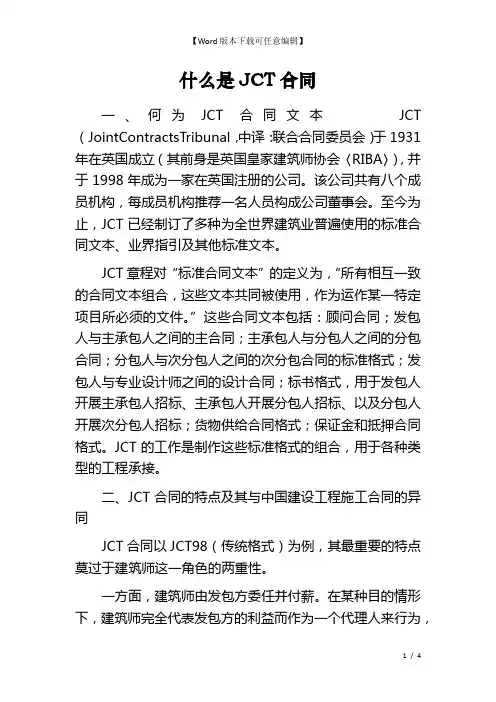
什么是JCT合同一、何为JCT合同文本JCT (JointContractsTribunal,中译:联合合同委员会)于1931年在英国成立(其前身是英国皇家建筑师协会〈RIBA〉),并于1998年成为一家在英国注册的公司。
该公司共有八个成员机构,每成员机构推荐一名人员构成公司董事会。
至今为止,JCT已经制订了多种为全世界建筑业普遍使用的标准合同文本、业界指引及其他标准文本。
JCT章程对“标准合同文本”的定义为,“所有相互一致的合同文本组合,这些文本共同被使用,作为运作某一特定项目所必须的文件。
”这些合同文本包括:顾问合同;发包人与主承包人之间的主合同;主承包人与分包人之间的分包合同;分包人与次分包人之间的次分包合同的标准格式;发包人与专业设计师之间的设计合同;标书格式,用于发包人开展主承包人招标、主承包人开展分包人招标、以及分包人开展次分包人招标;货物供给合同格式;保证金和抵押合同格式。
JCT的工作是制作这些标准格式的组合,用于各种类型的工程承接。
二、JCT合同的特点及其与中国建设工程施工合同的异同JCT合同以JCT98(传统格式)为例,其最重要的特点莫过于建筑师这一角色的两重性。
一方面,建筑师由发包方委任并付薪。
在某种目的情形下,建筑师完全代表发包方的利益而作为一个代理人来行为,例如决定发布一个指示来修改工程。
作为发包方的代理人,适用民法上关于代理人的法律规定,即其行为的法律后果由发包人担负。
另一方面,在其他情况下,建筑师负有依合同以独立的职业理念来作出决定或提出观点的职责,而不偏袒发包方或承包方。
对于建筑师所作出的决定,承包方可以要求建筑师提供作出此项决定的相关信息,如对此不满意,承包方在遵从这一决定之时可依合同提起争议解决程序,即交由仲裁人裁决,或通过法院诉讼解决。
但在原材料的质量或工艺标准等方面,建筑师可以依据合同条款作出最终证书,如果在最终证书作出后的28天内承包方和发包方未提起争议程序,则最终证书的决定应当被遵守。
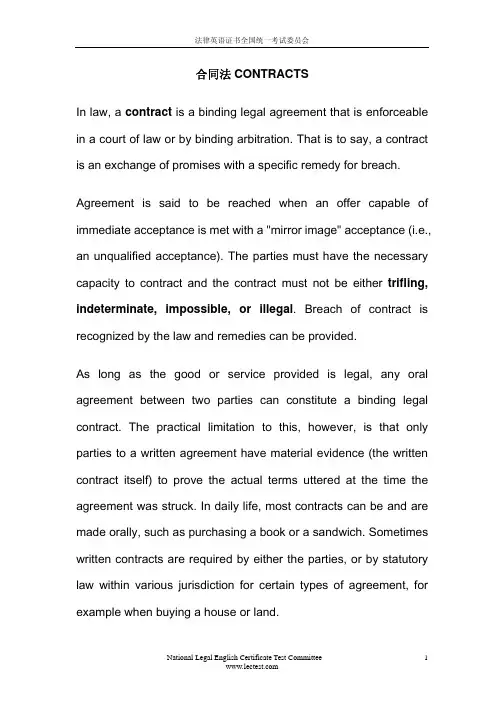
合同法CONTRACTSIn law, a contract is a binding legal agreement that is enforceable in a court of law or by binding arbitration. That is to say, a contract is an exchange of promises with a specific remedy for breach. Agreement is said to be reached when an offer capable of immediate acceptance is met with a "mirror image" acceptance (i.e., an unqualified acceptance). The parties must have the necessary capacity to contract and the contract must not be either trifling, indeterminate, impossible, or illegal. Breach of contract is recognized by the law and remedies can be provided.As long as the good or service provided is legal, any oral agreement between two parties can constitute a binding legal contract. The practical limitation to this, however, is that only parties to a written agreement have material evidence (the written contract itself) to prove the actual terms uttered at the time the agreement was struck. In daily life, most contracts can be and are made orally, such as purchasing a book or a sandwich. Sometimes written contracts are required by either the parties, or by statutory law within various jurisdiction for certain types of agreement, for example when buying a house or land.Contract formationIn common-law systems, the five key requirements for the creation of a contract are:1. offer and acceptance (agreement)2. consideration3. an intention to create legal relations4. legal capacity5. formalitiesOffer and acceptance analysis is a traditional approach in contract law used to determine whether an agreement exists between two parties. As a contract is an agreement, an offer is an indication by one person (the "offeror") to another (the "offeree") of the offeror's willingness to enter into a contract on certain terms without further negotiations. A contract is said to come into existence when acceptance of an offer (agreement to the terms in it) has been communicated to the offeror by the offeree.Treitel defines an offer as "an expression of willingness to contract on certain terms, made with the intention that it shall become binding as soon as it is accepted by the person to whom it isaddressed", the "offeree". An offer is a statement of the terms on which the offeror is willing to be bound.The "expression" referred to in the definition may take different forms, such as a letter, newspaper, fax, email and even conduct, as long as it communicates the basis on which the offeror is prepared to contract.Whether two parties have an agreement or a valid offer is an issue which is determined by the court using the Objective test (Smith v. Hughes). Therefore the "intention" referred to in the definition is objectively judged by the courts. In the English case of Smith v. Hughes the court emphasised that the important thing is not a party's real intentions but how a reasonable person would view the situation. This is due mainly to common sense as each party would not wish to breach his side of the contract if it would make him or her culpable to damages, it would especially be contrary to the principle of certainty and clarity in commercial contract and the topic of mistake and how it affects the contract. As a minimum requirement the conditions for an offer should include at least the following 4 conditions: Delivery date, price, terms of payment that includes the date of payment and detail description of the item on offer including a fair description of the condition or type ofservice. Without one of the minimum requirements of condition an offer of sale is not seen as a legal offer but rather seen as an advertisement.Acceptance is a final and unqualified expression of assent to the terms of an offer. It is no defense to an action based on a contract for the defendant to claim that he had not intended to be bound by the agreement, if his conduct demonstrated that he had.Rules of acceptanceThere are several rules dealing with the communication of acceptance:•The acceptance must be communicated: see Powell v Lee (1908) Prior to acceptance, an offer may be withdrawn.•An exception exists in the case of unilateral contracts, in which the offeror makes an offer to the world which can be accepted by some act. A classic instance of this is the case ofCarlill v. Carbolic Smoke Ball Co. [1892] 2 Q.B. 484 in which an offer was made to pay £100 to anyone who having boughtthe offeror's product and used it in accordance with the instructions nonetheless contracted influenza. The plaintiff did so and the court ordered payment of the £100. Heractions accepted the offer - there was no need to communicate acceptance. Typical cases of unilateral offers are advertisements of rewards (e.g., for the return of a lost dog).•An offer can only be accepted by the offeree, that is, the person to whom the offer is made.•An offeree is not usually bound if another person accepts the offer on his behalf without his authorization, the exceptions to which are found in the law of agency, where an agent may have apparent or ostensible authority, or the usual authority of an agent in the particular market, even if the principal did not realize what the extent of this authority was, and someone on whose behalf an offer has been purportedly accepted it may also ratify the contract within a reasonable time, binding both parties.•It may be implied from the construction of the contract that the offeror has dispensed with the requirement of communication of acceptance (called waiver of communication - which is generally implied in unilateral contracts): see also Re Selectmove Ltd [1994] BCC 349.•If the offer specifies a method of acceptance (such as by post or fax), acceptance must be by a method that is no lesseffective from the offeror's point of view than the method specified. The exact method prescribed may have to be used in some cases but probably only where the offeror has used very explicit words such as "by registered post, and by that method only": see Yates Building Co. Ltd v. R.J. Pulleyn & Sons (York) Ltd (1975) 119 Sol. Jo. 370.•Silence cannot be construed as acceptance: see Felthouse v.Bindley (1862) 142 ER 1037.•However, acceptance may be inferred from conduct.Vitiating FactorsThere are the factors affecting the validity of an otherwise effective contract. They include mistakes, misrepresentation, duress, undue influence and illegality.DischargeOnce it is determined that a party is under an immediate duty to perform, the duty to perform must be discharged. A contract may be discharged in one of the following ways:·By performance·By tender of performance·By frustration·By operation of law·By occurrence of condition subsequent·By illegality·By rescission·By novation·By cancellation·By release·By substituted contract·By accord and satisfaction·By account stated·By lapse·By effect of running of statute of limitationsBreach of contract is a legal concept in which a binding agreement or bargained-for exchange is not honored by one or more of the parties to the contract by non-performance orinterference with the other party's performance. If the party does not fulfill his contractual promise, or has given information to the other party that he will not perform his duty as mentioned in the contract or if by his action and conduct he seems to be unable to perform the contract, he is said to breach the contract.Remedies for Breach of Contract•Damages, which may include:o Compensatory damageso Punitive damageso Incidental damageso Liquidated damageso Nominal damages•Coercive reliefo Specific performanceo Injunctionso Restitutiono Account of profits【版权声明】《合同法CONTRACTS》的版权属于法律英语证书(LEC)全国统一考试委员会所有。
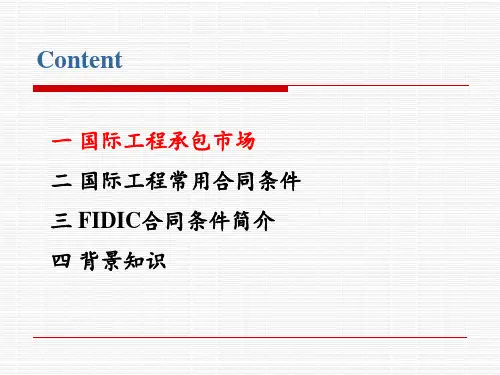
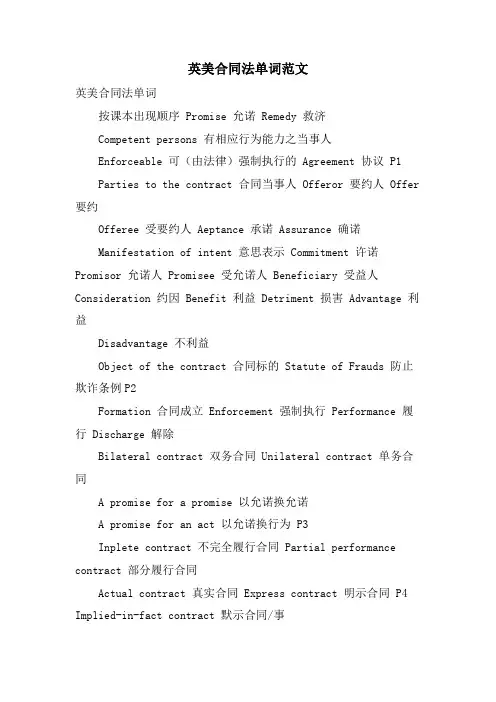
英美合同法单词范文英美合同法单词按课本出现顺序 Promise 允诺 Remedy 救济Competent persons 有相应行为能力之当事人Enforceable 可(由法律)强制执行的 Agreement 协议 P1Parties to the contract 合同当事人 Offeror 要约人 Offer 要约Offeree 受要约人 Aeptance 承诺 Assurance 确诺Manifestation of intent 意思表示 Commitment 许诺Promisor 允诺人 Promisee 受允诺人 Beneficiary 受益人Consideration 约因 Benefit 利益 Detriment 损害 Advantage 利益Disadvantage 不利益Object of the contract 合同标的 Statute of Frauds 防止欺诈条例P2Formation 合同成立 Enforcement 强制执行 Performance 履行 Discharge 解除Bilateral contract 双务合同 Unilateral contract 单务合同A promise for a promise 以允诺换允诺A promise for an act 以允诺换行为 P3Inplete contract 不完全履行合同 Partial performance contract 部分履行合同Actual contract 真实合同 Express contract 明示合同 P4 Implied-in-fact contract 默示合同/事实默示的合同 P5Quasi-contract 准合同 / implied-in-law contract 法律默示的合同Meeting of minds 合意 Injustice 不公正Unjust eichment 不当得利Objective theory of contract 合同客观理论Intent 意图Resonably prudent person standard 合理慎重人的标准 In jest 开玩笑 In anger 生气In excitement 兴奋状态 Invalid 无效 P6 Formal contract 要式合同 Contacts under seal 盖印合同 Recognizance 具结Acknowledge 成认Negotiable instruments 可转让票据 Letters of credit 信用证 Invoice 发票;发货单 Bill of lading 提单Informal contract 非要式合同/simple contract 简单合同P8 Valid contract 有效合同 Void contract 无效合同Voidable contract 可撤销合同Unenforceable contract 不可强制执行的合同Contractual capacity 订约能力Nondisclosure agreement/NDA 保密协议Minors 未成年人Insane persons 精神病者 Intoxicated persons 酗酒人Duress 胁迫Undue influence 不正当影响 Fraud 欺诈 P9Cases involving mutual mistake 双方都有误解的合同Contract at will 任意合同 Excuted contract/performedcontract/pleted contract 已履行/已完成的合同Excutory contract 待执行合同 P10Sources of contract law 合同法的渊源 Common law 普通法/judge-made law 法官造法General principle 一般法律原那么The Uniform Commercial Code/UCC 统一商法典National Conference of Commission on Uniform State Law 美国统一州级法律委员会全国大会 Draft 起草(法律) Merchant 商人P11Restatement of the law, Second:Contracts 法律整编第二版:合同法 The American Law Institute 美国法学会The Convention on Contracts for the International Sale of Goods/CISG 联合国国际货物买卖销售合同公约Firm offer rule 实盘规那么(不可撤销要约规那么)Mailbox rule 发信主义 Battle of forms 格式之争 Mirror image rule 镜像规那么 P12Jurisprudential foundation 法理学根底Legal realism 法律现实主义 Open-ended standard 开口标准Formalities 形式 Make whole 填平Electronic Signature Act 电子签章法 P13Electronic sound 电子声音 Electronic symbol 电子符号Electronic process 电子程序 Preserve 保存 In writing 书面Laissez-faire 放任政策Freedom of contract 合同自由 P14Classical law of contracts 古典合同法理论Objective rules 客观规那么 Certainty 确定性Predictability 可预见性Chain of distribution for goods 物流链 Form contract 标准合同Automobile contract 汽车买卖合同 Mortgage contract 抵押合同Sale contracts for consumer goods 消费品买卖合同Legal theories 法律原理/理论 Oppressive 强制性Decisional law 判例法Small-town virtue 小城道德标准 Interest of business 商业的利益 Rural context 农村环境 Urban context 城市环境 P15 Defenses to the enforcement of a contract 对合同履行的抗辩Trade usage 行业惯例Specific performance 强制履行 Expectation interest 预期利益 Reliance interest 信赖利益Substitute performance 替代履行 Restitution 恢复原状Genuineness of assent 同意的真实性 Duress 胁迫Undue influence 不正当影响 Fraud 欺诈 P16Writing and form 书面和形式问题 Equity 衡平Court of mon law 普通法院Chancery court/court of equity 衡平法院Fairness 公平Moral rights道德权利 Natural law 自然法Doctrine of equity 衡平准那么 P17Lawyers 法律人 Case law 判例法Public policy 社会公共政策 P19Novation (合同)更新 Liquidated damages 违约金Covenant of good faith 善意条款 P20Mutual assent 双方同意A reasonably prudent person 合理慎重人 P21 Offeror 要约人 Offeree 受要约人 Promise 承诺 Aept 承诺Invitation to negotiate 要约邀请/谈判邀请Form letter 格式信函 Quote 报价Promissory estoppel 允诺禁反言;不得自食其言 P22Standard of offer 判断要约的标准 A reasonable person 合理人标准 P31Prevail 优先 P33 Terms of offer 要约的条件P38Open terms 开放条款Gap-filling rule 空隙填补规那么 Time of performance 履行时间 P40Quantum meruit 按劳付酬;按合理价格支付;质量价值Quasi contract 准合同 P43 Communication of offer 要约的传达 Supported by consideration 有约因支持的Option 选择权Irrevocable 不可撤销的Firm offers 不可撤销的要约/实盘要约 P47Offers in auction 拍卖的要约Auction without reserve 无保存的拍卖Auction wiht reserve 有保存的拍卖 Collateral contract 附随合同;附属契约 P50Auction in electronic merce 电子商务拍卖 P53Termination of offer 要约的终止 P54Lapse of time 逾时;期满失效 P55Revocation of offer 要约的撤回 P56Offeree’s refusal of offer 受要约人回绝要约Counter-offer 反要约Mirror aeptance 镜像规那么 P62Option 选择权 P64 Termination by law P65Terms and conditions 条款和条件 Counter-offer 反要约Mirror aeptance rule 镜像承诺规那么 P68Cross offers 穿插要约 P71Indefiniteness 缺乏确定性;不确定性 P72Meeting of minds 达成合意Entry-into-force time of aeptance 承诺的生效时间Aeptance-upon-dispatch rule/mailbox rule 承诺发出主义/投邮主义 P73Quiet title to the land 确认土地所有权 P74Option contract 选择权合同 P75 Promise 允诺Performance 履行 P77 General contractor 总承包商Subcontractor 次承包商 P82 Malpractice 玩忽职守;不当执业P86Implied-in-fact contract 事实默示的合同 P87Good faith 诚信原那么Reasonableness 合理性原那么 P93Commercial reasonableness 商业合理性 P94Unconscionability不正当;显失公平;不受良心控制Liquidated damage clause 预定损害赔偿条款Battle of the forms 格式信函之战 P95Gap-filling rule 空隙填补规那么 Merchantability 适售性P96Proposals for addition to the contract 对合同的补充建议P97 Different terms 不同条款 Additional terms 额外条款Merchants 商人Non-merchants 非商人Materially alter 实质性变更 Complaint 抱怨 Warranty 担保Merchantability 适售性 Fitness 合目的性 P98Impacts of E-merce and web-laws on the forms 电子商务与网络法对格式合同的影响Shrink wrap license 拆封许可 P102Public policy 公共政策 P103 An enforceable contract 有强制力的合同Consideration 约因Inducement/incentives 诱因 Detriment 损害Impelling influence 强有力的影响因素Bargaining 讨价还价Legal detriment or disadvantage 法律上的损失或不利益Quid pro quo 对价 Gift 赠与 P112Contract in signed writing 经签署的书面合同Supported by consideration 已受约因支持Contract under seal 盖印合同 Forbearance 忍耐/克制 P115 Sufficient consideration 充分的约因 Gift promise 赠与的允诺P116Nominal consideration 名义上的约因Shocks the conscience of the court 震惊法庭的良心Adequacy of consideration 约因的适当性 P123Sufficiency of consideration 约因的充分性Nominal 有名无实的;名义上的 Equity 衡平法 P124Forbearance from suit 容忍不诉 Past consideration 过去的约因 Moral obligation 道德义务 P125 Quantum meruit 所提供效劳之实际价值Good consideration 有效的约因 P126Moral consideration 道德约因 Legal consideration 法律约因 P131Pre-existing duty 既存的义务 P132Modification of contract 合同的修改 P135Sales contract 买卖合同 Termination 终止(合同)Rescission 解除(合同) Unforeseen and unanticipated circumstances 无法预料、不曾预见之情况Estoppel 禁反言 Waiver 弃权 P137Executory contract 待履行合同Compromising an existing claim 既存请求权的妥协Bona fide dispute “真实的”或“善意的争议” P139 Aord 新债清偿合同 Satisfaction 满足Aord and satisfaction 新债清偿合同与满足 P140Illusory promise 虚假允诺Mutuality of obligation 义务相互性 P144Output contract 产量合同Requirement contract 需求合同 P148Stale claims 逾时失效的请求权 The statue of limitations 诉讼时效 Discharge in bankruptcy 破产免责 New consideration 新约因 P150 Forbearance from suit 隐忍不诉Abstention from legal conduct 合法行为的节制Detriment 利益损失 P152 A bona fide suit 善意诉讼Sufficient consideration 充分的约因 P153Aleatory promise 不确定/偶然性的承诺Promissory estoppel 允诺性禁反言 P158Injustice 不公正 Remedies 救济Unjust eichment 不当得利 P159Parol evidence rule 口头证据法那么 Terms and conditions 条款和条件 Parol 口头的 In writing 书面的Extrinsic evidence 外在证据 P174Integration 整合Final and plete 最终且完整的 Partial integration 部分整合Final but not plete 最终但不完全 Prior writings andoral agreement 事前的书面和口头协议Contemporaneous writing 同时书面 Subsequent agreements 事后协议 No oral modification clause 制止头变更条款 P175 Reliability of writings 书面的可靠性 A principle of substance 实体法律原那么 P176Procedural substantive 程序的实体性 Diversity jurisdiction 区分管辖权 P177Final and plete writings 最终且完整的书面The statute of frauds 防止欺诈条例 Memorandum 备忘录P197 Partial integrated 部分整合 Total integrated 完全整合Additional prior non-contradictory parol terms 协议订立前的非抵触性的其他口头条件Informality 不标准;非正式Completely integrated writing 完全整合的书面Fully integrated/pleted 完全整合的Form approach 形式的方法 P198 The face of the contract 合同的外表 Extrinsic evidence 外来证据 Intrinsic evidence 内在证据 Merger clause 归并条款Verbal understandings 口头谅解书 P199Implied terms (合同的)默示条款 Separate consideration 独立的约因 Separate agreement 分别的协议 P202Substituting or contradicting terms 替代或变更原有条款Express language 明示语言 P220 Extra or additional terms 额外或附属条款Side or collateral agreement 额外或附属协议Merger clause 归并条款Separate consideration 独立的约因 P221Ambiguity/ambiguities 含混不清之处 Latent 隐性的/ 潜在的 Patent 显性的 P222Terms based on custom 依据惯例确立的合同条款Course of dealing 交易过程Custom and usage of the trade 行业惯例Prior negotiations 订约前协商Antecedent understanding 签约前协英美法与大陆法在对合同的理解上走了完全不同的两条路,在大陆法下,合同作为债的原因而存在,基于这一理念,或者说是基于这一理论抽象,大陆法的民法体系将合同与侵权、无因管理、不当得利等沟通起来;而在英美法里,合同只是有法律强制力的当事人之间互有联系的承诺而已。
![[法学]国际私法合同的适用](https://uimg.taocdn.com/1ada525501f69e3142329407.webp)

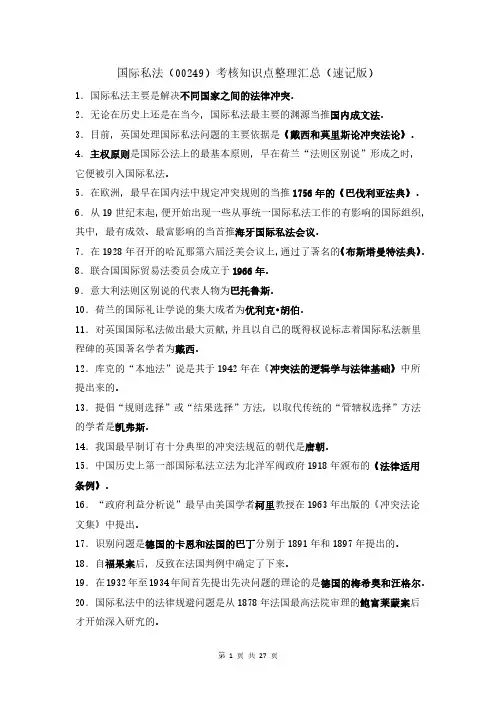
国际私法(00249)考核知识点整理汇总(速记版)1.国际私法主要是解决不同国家之间的法律冲突。
2.无论在历史上还是在当今,国际私法最主要的渊源当推国内成文法。
3.目前,英国处理国际私法问题的主要依据是《戴西和莫里斯论冲突法论》。
4.主权原则是国际公法上的最基本原则,早在荷兰“法则区别说”形成之时,它便被引入国际私法。
5.在欧洲,最早在国内法中规定冲突规则的当推1756年的《巴伐利亚法典》。
6.从19世纪末起,便开始出现一些从事统一国际私法工作的有影响的国际组织,其中,最有成效、最富影响的当首推海牙国际私法会议。
7.在1928年召开的哈瓦那第六届泛美会议上,通过了著名的《布斯塔曼特法典》。
8.联合国国际贸易法委员会成立于1966年。
9.意大利法则区别说的代表人物为巴托鲁斯。
10.荷兰的国际礼让学说的集大成者为优利克•胡伯。
11.对英国国际私法做出最大贡献,并且以自己的既得权说标志着国际私法新里程碑的英国著名学者为戴西。
12.库克的“本地法”说是其于1942年在《冲突法的逻辑学与法律基础》中所提出来的。
13.提倡“规则选择”或“结果选择”方法,以取代传统的“管辖权选择”方法的学者是凯弗斯。
14.我国最早制订有十分典型的冲突法规范的朝代是唐朝。
15.中国历史上第一部国际私法立法为北洋军阀政府1918年颁布的《法律适用条例》。
16.“政府利益分析说”最早由美国学者柯里教授在1963年出版的《冲突法论文集》中提出。
17.识别问题是德国的卡恩和法国的巴丁分别于1891年和1897年提出的。
18.自福果案后,反致在法国判例中确定了下来。
19.在1932年至1934年间首先提出先决问题的理论的是德国的梅希奥和汪格尔。
20.国际私法中的法律规避问题是从1878年法国最高法院审理的鲍富莱蒙案后才开始深入研究的。
21.公共秩序保留被称为国际私法中的“安全阀”。
22.布鲁歇把有关公共秩序的强行法分为“国内公共秩序法”和“国际公共秩序法”。
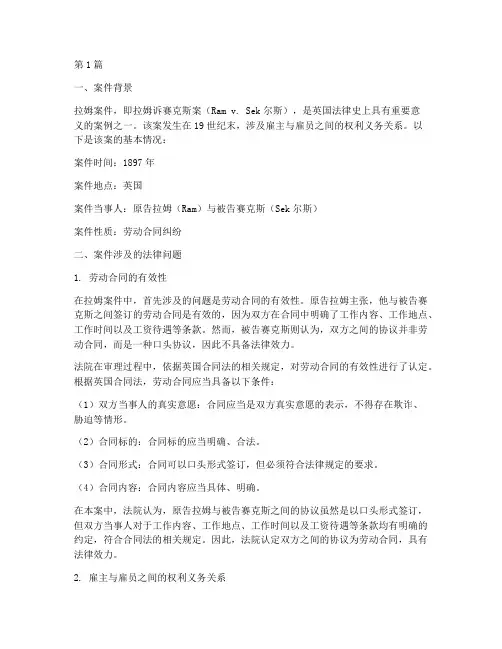
第1篇一、案件背景拉姆案件,即拉姆诉赛克斯案(Ram v. Sek尔斯),是英国法律史上具有重要意义的案例之一。
该案发生在19世纪末,涉及雇主与雇员之间的权利义务关系。
以下是该案的基本情况:案件时间:1897年案件地点:英国案件当事人:原告拉姆(Ram)与被告赛克斯(Sek尔斯)案件性质:劳动合同纠纷二、案件涉及的法律问题1. 劳动合同的有效性在拉姆案件中,首先涉及的问题是劳动合同的有效性。
原告拉姆主张,他与被告赛克斯之间签订的劳动合同是有效的,因为双方在合同中明确了工作内容、工作地点、工作时间以及工资待遇等条款。
然而,被告赛克斯则认为,双方之间的协议并非劳动合同,而是一种口头协议,因此不具备法律效力。
法院在审理过程中,依据英国合同法的相关规定,对劳动合同的有效性进行了认定。
根据英国合同法,劳动合同应当具备以下条件:(1)双方当事人的真实意愿:合同应当是双方真实意愿的表示,不得存在欺诈、胁迫等情形。
(2)合同标的:合同标的应当明确、合法。
(3)合同形式:合同可以口头形式签订,但必须符合法律规定的要求。
(4)合同内容:合同内容应当具体、明确。
在本案中,法院认为,原告拉姆与被告赛克斯之间的协议虽然是以口头形式签订,但双方当事人对于工作内容、工作地点、工作时间以及工资待遇等条款均有明确的约定,符合合同法的相关规定。
因此,法院认定双方之间的协议为劳动合同,具有法律效力。
2. 雇主与雇员之间的权利义务关系在拉姆案件中,另一个涉及的法律问题是雇主与雇员之间的权利义务关系。
根据英国劳动法,雇主与雇员之间的权利义务关系主要体现在以下几个方面:(1)雇主有义务为雇员提供安全的工作环境,确保其身体健康和生命安全。
(2)雇主有义务按照合同约定支付雇员工资。
(3)雇员有义务按照合同约定履行工作职责。
(4)雇员有义务遵守雇主制定的规章制度。
在本案中,原告拉姆主张,被告赛克斯未能为他提供安全的工作环境,导致他在工作中受伤。
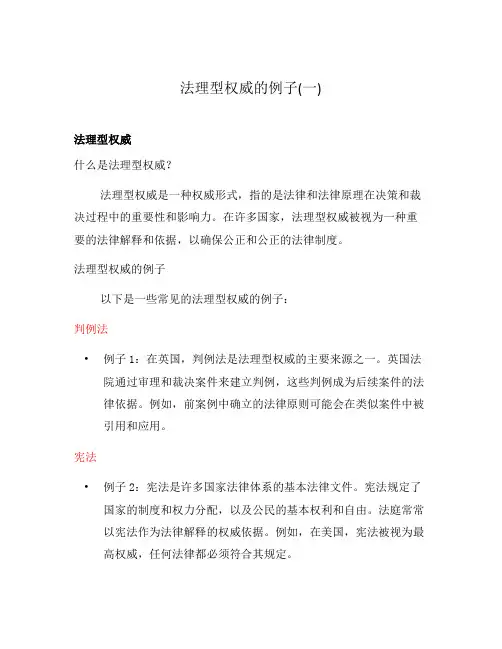
法理型权威的例子(一)法理型权威什么是法理型权威?法理型权威是一种权威形式,指的是法律和法律原理在决策和裁决过程中的重要性和影响力。
在许多国家,法理型权威被视为一种重要的法律解释和依据,以确保公正和公正的法律制度。
法理型权威的例子以下是一些常见的法理型权威的例子:判例法•例子1:在英国,判例法是法理型权威的主要来源之一。
英国法院通过审理和裁决案件来建立判例,这些判例成为后续案件的法律依据。
例如,前案例中确立的法律原则可能会在类似案件中被引用和应用。
宪法•例子2:宪法是许多国家法律体系的基本法律文件。
宪法规定了国家的制度和权力分配,以及公民的基本权利和自由。
法庭常常以宪法作为法律解释的权威依据。
例如,在美国,宪法被视为最高权威,任何法律都必须符合其规定。
法律原则•例子3:法律原则是广泛适用和有普遍适用性的法律规则,常常被用作决策和裁决的依据。
例如,在合同法中,有一个常见的原则是“契约精神”,即契约的各方必须诚实履行其义务。
法庭可能会引用这一原则,以确定契约违法的程度和补救措施。
法学文献•例子4:法学文献,包括法学教科书、法学论文和法律评论,也被认为是法理型权威的来源。
在这些文献中,法学家对法律原则和解释进行了深入研究和分析。
法院可能会参考法学文献,以理解法律条文和解释的背景和意图。
法理型权威的重要性法理型权威的重要性在于确保法律的一致性、公正性和可预测性。
通过引用法理型权威,法院可以遵循已经建立的法律原则,避免主观性和歧义性的判断,并提供一个公正和可信赖的决策依据。
此外,法理型权威还促进了法律制度的稳定性和连续性。
通过遵循法理型权威,法律的解释和执行可以在不同的案例中保持一致,从而消除法律的不确定性和不一致性。
总结起来,法理型权威在法律领域扮演着重要的角色,它源自于判例法、宪法、法律原则和法学文献等多个方面。
通过遵循法理型权威,法院可以确保公正和一致的决策,同时维护法律制度的稳定性和连续性。
法理型权威对司法判断的影响•例子1:在美国,《布朗诉教育委员会案》(Brown v. Board of Education)是一个重要的判例,它终结了种族隔离教育政策,并宣布“分离但平等”原则违反宪法。
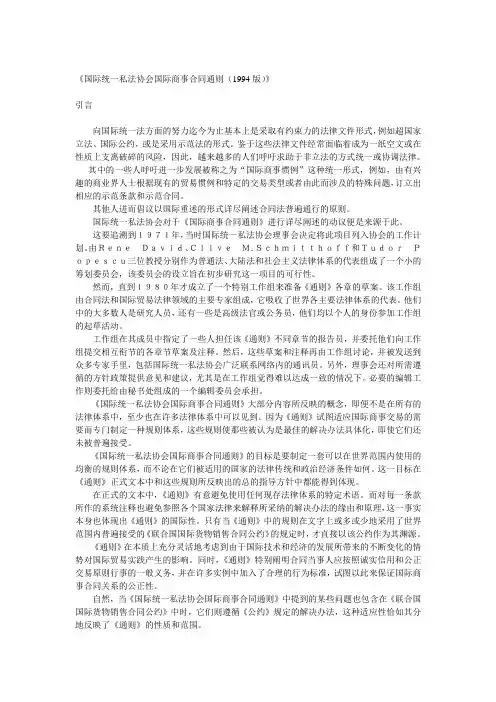
《国际统一私法协会国际商事合同通则(1994版)》引言向国际统一法方面的努力迄今为止基本上是采取有约束力的法律文件形式,例如超国家立法、国际公约,或是采用示范法的形式。
鉴于这些法律文件经常面临着成为一纸空文或在性质上支离破碎的风险,因此,越来越多的人们呼吁求助于非立法的方式统一或协调法律。
其中的一些人呼吁进一步发展被称之为“国际商事惯例”这种统一形式,例如,由有兴趣的商业界人士根据现有的贸易惯例和特定的交易类型或者由此而涉及的特殊问题,订立出相应的示范条款和示范合同。
其他人进而倡议以国际重述的形式详尽阐述合同法普遍通行的原则。
国际统一私法协会对于《国际商事合同通则》进行详尽阐述的动议便是来源于此。
这要追溯到1971年,当时国际统一私法协会理事会决定将此项目列入协会的工作计划。
由ReneDavid、CliveM.Schmitthoff和TudorPopescu三位教授分别作为普通法、大陆法和社会主义法律体系的代表组成了一个小的筹划委员会,该委员会的设立旨在初步研究这一项目的可行性。
然而,直到1980年才成立了一个特别工作组来准备《通则》各章的草案。
该工作组由合同法和国际贸易法律领域的主要专家组成,它吸收了世界各主要法律体系的代表。
他们中的大多数人是研究人员,还有一些是高级法官或公务员,他们均以个人的身份参加工作组的起草活动。
工作组在其成员中指定了一些人担任该《通则》不同章节的报告员,并委托他们向工作组提交相互衔节的各章节草案及注释。
然后,这些草案和注释再由工作组讨论,并被发送到众多专家手里,包括国际统一私法协会广泛联系网络内的通讯员。
另外,理事会还对所需遵循的方针政策提供意见和建议,尤其是在工作组觉得难以达成一致的情况下。
必要的编辑工作则委托给由秘书处组成的一个编辑委员会承担。
《国际统一私法协会国际商事合同通则》大部分内容所反映的概念,即便不是在所有的法律体系中,至少也在许多法律体系中可以见到。
因为《通则》试图适应国际商事交易的需要而专门制定一种规则体系,这些规则使那些被认为是最佳的解决办法具体化,即使它们还未被普遍接受。
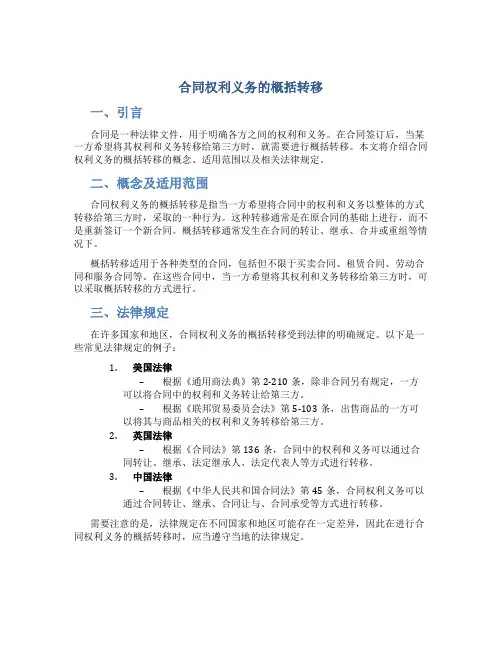
合同权利义务的概括转移一、引言合同是一种法律文件,用于明确各方之间的权利和义务。
在合同签订后,当某一方希望将其权利和义务转移给第三方时,就需要进行概括转移。
本文将介绍合同权利义务的概括转移的概念、适用范围以及相关法律规定。
二、概念及适用范围合同权利义务的概括转移是指当一方希望将合同中的权利和义务以整体的方式转移给第三方时,采取的一种行为。
这种转移通常是在原合同的基础上进行,而不是重新签订一个新合同。
概括转移通常发生在合同的转让、继承、合并或重组等情况下。
概括转移适用于各种类型的合同,包括但不限于买卖合同、租赁合同、劳动合同和服务合同等。
在这些合同中,当一方希望将其权利和义务转移给第三方时,可以采取概括转移的方式进行。
三、法律规定在许多国家和地区,合同权利义务的概括转移受到法律的明确规定。
以下是一些常见法律规定的例子:1.美国法律–根据《通用商法典》第2-210条,除非合同另有规定,一方可以将合同中的权利和义务转让给第三方。
–根据《联邦贸易委员会法》第5-103条,出售商品的一方可以将其与商品相关的权利和义务转移给第三方。
2.英国法律–根据《合同法》第136条,合同中的权利和义务可以通过合同转让、继承、法定继承人、法定代表人等方式进行转移。
3.中国法律–根据《中华人民共和国合同法》第45条,合同权利义务可以通过合同转让、继承、合同让与、合同承受等方式进行转移。
需要注意的是,法律规定在不同国家和地区可能存在一定差异,因此在进行合同权利义务的概括转移时,应当遵守当地的法律规定。
四、概括转移的程序进行合同权利义务的概括转移通常需要经过一定的程序。
以下是一般概括转移的程序:1.协商一致转让方和受让方应当就转让的权利和义务进行协商,并达成一致意见。
2.书面通知转让方应当向受让方发出书面通知,明确转让的权利和义务,并在通知中指定转让的日期。
3.合同转移登记部分国家和地区要求进行合同转移登记手续,以确保转移的合法性和有效性。
主体法律中华人民共和国对外贸易法(1994年5月12日第八届全国人民代表大会常务委员会第七次会议通过)中华人民共和国海关法(1987年1月22日第六届全国人民代表大会常务委员会第十九次会议通过 2000年7月8日第九届全国人民代表大会常务委员会第十六次会议修正)中华人民共和国海商法(1992年11月7日第七届全国人民代表大会常务委员会第28次会议通过)中华人民共和国货物进出口管理条例(10月31日国务院第46次常务会议通过自2002年1月1日起施行)中华人民共和国国际海运条例(2001年12月 5日国务院第49次常务会议通过自2002年1月1日起施行)中华人民共和国反倾销条例(2001年10月五日国务院第46次常务会议通过中华人民共和国反补贴条例(2001年10月31日国务院第46次常务会议通过中华人民共和国国务院令第329号)司法解释链接最高人民法院关于审理国际贸易行政案件苦干问题的规定(2002年8月27日最高人民法院审判委员会第1239次会议通过)法释[2002〕27号最高人民法院关于审理反倾销行政案件应用法律若干问题的规定(2002年9月11日最高人民法院审判委员会第1242次会议通过法释[2002]35号)最高人民法院关于审理反补贴行政案件应用法律若干问题的规定(2002年9月11日最高人民法院审判委员会第1242次会议通过法释[2002]36号)相关规定链接中华人民共和国进出口商品检验法实施条例(1992年10月7日国务院批准10月23日国家进出口商品检验局分第5号发布)农产品进口关税配额管理暂行办法(中华人民共和国国家发展计划委员会今2002年第19号)货物进口许可证管理办法(2002年1月1日发布)软件出口管理和统计办法(2001年10月25日发布)纺织品被动配额管理办法(中华人民共和国对外贸易经济合作部令 2001年第28号)机电产品进口管理办法(对外贸易经济合作部、海关总署、国家质量监督检验检疫总局令2001年第10号)机电产品进口配额管理实施细则(中华人民共和国对外贸易经济合作部2001年第23号令)特定机电产品进口管理实施细则(中华人民共和国对外贸易经济合作部、海关总署今2001年第24号)货物进口指定经营管理办法(中华人民共和国对外贸易经济合作部令2001年第21号)禁止进口限制进口技术管理办法(中华人民共和国对外贸易经济合作部、国家经济贸易委员会令2001年第18号)技术进出口合同登记管理办法(中华人民共和国对外贸易经济合作部分2001年第17号)出口商品配额管理办法(中华人民共和国对外贸易经济合作部2001年第12号令)出口商品配额招标办法(中华人民共和国对外贸易经济合作部分2001年第11号)出口许可证管理规定(中华人民共和国对外贸易经济合作部令2001年第9号)关于进出口经营资格管理的有关规定(中华人民共和国对外贸易经济合作部2001年7月10日公布)倾销及倾销幅度期中复审暂行规则(中华人民共和国对外贸易经济合作部2002年第23号令)反倾销退税暂行规则(中华人民共和国对外贸易经济合作部2002年第22号令)反倾销新出口商复审暂行规则(中华人民共和国对外贸易经济合作部2002年第21号令)反倾销价格承诺暂行规则(中华人民共和国对外贸易经济合作部2002年第20号令)反倾销调查公开信息查阅暂行规则(中华人民共和国对外贸易经济合作部2002年第19号令)反倾销调查信息披露暂行规则(中华人民共和国对外贸易经济合作部2002年第18号令)反倾销调查抽样暂行规则(中华人民共和国对外贸易经济合作部2002年第15号令)反倾销问卷调查暂行规则(中华人民共和国对外贸易经济合作部2002年第14号令)反倾销调查实地核查暂行规则(中华人民共和国对外贸易经济合作部2002年第13号令) 反补贴调查实地核查暂行规则(中华人民共和国对外贸易经济合作部2002年第17号令) 反补贴问卷调查暂行规则(中华人民共和国对外贸易经济合作部2002年第16号令)国际贸易所适用的法律法规为保证国际贸易能够顺利进行,使国际贸易得到法律的承认与保护,国际贸易业务必须符合法律规范.但由于国际贸易的当事人一般身处不同的国家或地区,具有不同的法律和制度,因此,国际贸易所适用的法律法规有较大的不同。
英美民商法民商法是指民事法和商事法两个领域的法律规范,包括了英国和美国的相关法律制度。
一、英国民商法(英格兰和威尔士)英国的民商法主要基于英格兰和威尔士的法律体系,其特点是以普通法为基础。
普通法是通过法官的裁决和先例形成的法律制度。
以下是英国民商法的一些重要内容:1. 合同法:合同法规定了合同的成立、履行和违约的规则。
合同是个人或法人之间自愿达成的法律协议,合同法保护了合同双方的权益,并为违约行为提供救济措施。
2. 财产法:财产法涉及个人和企业的财产权利。
包括土地法、知识产权法、遗产法等。
财产法规定了财产的取得、转让和保护的规则。
3. 公司法:公司法规定了公司的组织、权力结构和经营管理等事项。
公司法保护了股东权益,规范了公司的运作和治理。
4. 侵权法:侵权法规定了个人或企业在侵犯他人权益时应承担的法律责任。
包括民事侵权和商业侵权等。
5. 劳动法:劳动法规定了雇佣关系中的权利和义务,保护了雇员的权益。
包括雇佣合同、工资和工时、解雇等方面的规定。
二、美国民商法美国的民商法是根据联邦法和各州法律体系形成的,其特点是联邦法与州法并存。
以下是美国民商法的一些重要内容:1. 合同法:美国合同法基于普通法,但在州际贸易中较多地使用联邦法。
合同法规定了合同的要素、成立和解释等。
2. 公法和私法:美国法律将法律分为公法和私法。
公法涉及政府与个人之间的关系,如宪法、行政法等。
私法涉及个人和企业之间的关系,如合同法、侵权法等。
3. 公司法:美国公司法涉及公司的组织、权力结构和经营管理等。
根据公司法,公司可以选择成为不同类型的实体,如有限责任公司(LLC)或股份有限公司(Inc.)。
4. 知识产权法:知识产权法保护创造性作品和创新性发明的权益,包括版权法、专利法和商标法等。
5. 竞争法:竞争法旨在保护市场竞争,预防垄断和不正当竞争行为。
美国的竞争法主要由联邦贸易委员会(FTC)和司法部反托拉斯部门执行。
总结起来,英美民商法是以普通法为基础的法律体系,涵盖了合同法、财产法、公司法、侵权法、劳动法等领很抱歉,由于字符限制,我无法继续提供更多内容。
中英两国建筑工程相关法律的比较1.从业务形式的角度建筑业是关系国计民生的国民经济生产行业之一,也是安全事故发生率最高的工业部门之一。
1鉴于这一领域的特殊性,其安全管理与健康发展已成为世界各国重点研究和关注的课题。
统计表明,建筑施工事故主要由人员和管理两方面的原因造成。
其中,导致事故发生的重要原因就是安全管理工作的缺失。
一般而言,建筑工人比其它行业工人在现场受伤的高许多。
建筑安全事故的发生率一直位于各行业之首,造成直接和间接的经济损失占项目总成本的比重也越来越大。
如英国,该比重为3% ~ 6%,而在中国香港,这一比例已达到8 . 5 %。
由此可见,安全问题已成为建筑业发展的巨大障碍。
英国在建筑安全管理方面率先颁布了一系列的法律法规,取得了卓越的成绩。
因此,从保障建筑业人员的安全和健康的角度出发,有必要借鉴英国建筑业的安全管理模式和理念,指导国内安全生产。
英国从 1901 ~ 2010 年相继颁布了一系列建筑安全法律法规,并对安全管理模式作了根本的调整。
通过法律法规强化政府监督职能,充分发挥行业协调作用,通过企业的自治自律,达到以人为本、促进工人自觉维护生产安全的目标。
英国在建筑安全管理方面的法律法规建设是最早的。
1974年,英国颁布了《劳动安全健康法》,明确规定了雇主应当保证雇员在健康安全的环境中工作的义务2,建筑施工单位必须为雇工及时足额地交纳工地安全保险金,其数额应为工程总造价的1 %3,使雇主必须明确自己的义务和职责。
1TAM C M,ZENG S X,DENG Z M. Identifying elements of poor construction safety management in China [J]. Safety Science,2003,42 (7): 569–586.2Health and Safety Executive. Statistical Information,2014. http: / /.3SWUSTE Paul,FRIJTERS Adri,GULDENMUND Frank. Is it possible to influence safety in the building sector: A literature review extending from 1980 until the present [J]. Safety Science,2012,50( 5) : 1333 - 1343.而在中国,随着《建筑法》、《安全生产法》等法律法规的相继颁布实施,国内建筑业的安全生产形势趋于好转,在建筑安全事故控制方面也取得了巨大的进步与成绩,同时也在完善安全管理运行机制方面取得了显著成效,使建筑安全管理工作能够健康稳步发展。
仲裁协议的独立性随着经济全球化,经济方式多样化发展,世界各国在全球经济交往过程中产生的纠纷越来越多,传统的纠纷解决方式例如诉讼等已经难以满足日益多变的经济纠纷,为此,人们寻求了更多的纠纷解决机制。
其中,仲裁,作为非诉纠纷解决机制的一种便顺应了时代的发展而生,它以其高效、便捷、经济的优势特征在解决当代经济纠纷中占据了一席之地。
一、仲裁协议独立性的概述仲裁协议的独立性,又称为仲裁协议的“可分性”或“自治性”。
其基本含义是指,尽管仲裁条款是主中的一个条款,但此条款与它所依据的合同是两个互相独立的合同。
如果争议涉及主合同的存在与否或其有效性问题,或者即使主合同无效或失效,仲裁条款作为双方当事人之间约定的解决合同争议的条款,仍可独立存在,并不由于主合同无效或失效而当然无效或失效[1]。
但是,仲裁协议的独立性并不是绝对的,而是一种相对特殊的独立性。
说它是一种相对特殊的独立性是因为:第一,它因主合同的订立而订立,随着主合同的完全履行而终结;第二,一旦成立,它就从效力上独立于主合同的效力。
说它的独立性不是绝对的,是因为它也有局限的一面:如果存在着影响主合同和主合同中的仲裁条款有效性的理由,那么仲裁协议可能不起作用或无效。
因此,仲裁协议并不总是可以存续的[2]。
二、仲裁协议独立性的理论依据之所以说仲裁协议独立于主合同,不因主合同效力的改变而改变,其主要理论依据是:1.当事人意思自治原则仲裁条款就其实质而言,是合同上的一项安排,是当事人之间共同的意思表示,它是当事人之间在订立合同时达成的将合同在履行中可能发生的争议交由仲裁解决,而不是诉诸法院的这一共同的意思表示。
就此意思表示而言,应该说是真实的,即使存在欺诈行为,也不影响仲裁协议的独立性;即使是不真实的意思表示,也不影响仲裁协议的独立性,仲裁条款仍可独立于该自始无效的合同而独立存在。
这也就是说,当事人意思自治原则排除了合同由于通过欺诈方式或者不真实意愿订立而被宣布为自始无效的情形,成为仲裁协议独立于主合同的前提。
【法宝引证码】 CLI.A.13241原文链接:/qikan/0e25b53ae6ebab9a3637724959564fe5bdfb.html中国大陆与香港地区合同效力问题之比较∙期刊名称:《中外法学》∙期刊年份:1995∙作者:王小能∙期号: 1∙页码: 6合同制度,是调整市场经济最有效的工具之一,而合同的效力问题,又是合同制度中尤为重要的。
随着中国大陆推行市场经济的经济体制,大陆与香港地区之间的贸易日趋增加,更随着1997年的接近,探讨两地在合同效力问题上的异同并尽可能寻求沟通的途径,这是推动两地经济发展十分有意义的工作。
本文拟从两地合同法的渊源人手,对合同的有效要件和无效因素进行分析和比较。
一、合同的有效要件中国大陆几个单行的合同法和若干个合同条例都未具体规定合同的有效要件。
《民法通则》明确规定了对民事法律行为应具备的条件。
所谓民事法律行为,“是公民或者法人设立、变更、终止民事权利和民事义务的合法行为”(《民法通则》第54条)。
据此定义可知,合同是一种民事法律行为,故而应具备《民法通则》第55条规定的如下要件:1行为人具有相应的民事行为能力;2.意思表示真实;3.不违反法律或者社会公共利益。
[1]在香港,根据普通法,合同的有效要件包括:1.合同的形式;2.合同对价;3.合同当事人的意向;4.合同当事人的订约能力;以及5.合同条件的明确性。
[2]对这些要件,本文择如下几项进行分析:(一)合同当事人的能力两地合同法都要求签订合同的人必须具有一定的能力(大陆叫“民事行为能力”,香港称“订约能力)。
在中国大陆,法律上将自然人的行为能力根据年龄和精神健康状况分为完全行为能力、限制行为能力和无行为能力。
在香港,18周岁以上的人为成年人,具有订约能力[3],未成年人、神经不正常的人以及醉酒人等,没有订约能力[4]。
如此看来,两地关于自然人的订约能力,大同小异。
18周岁是划分成年人与未成年人的明确界限。
英国法律委员会合同法(第三人权利)议案草案和海上货物运输一概论作为英国合同法的一个基本原则,合同当事人原则(privity of contract)已遭到司法系统和学术界的批评。
这些批评有时是由第三人试图援引提单和租船合同中的条款所遇到的困难而引发的(注:见j。
f。
wilson“a flcxible contract of carriage—the third dimcnsion?”[1996]lmclq187。
另,原文注释较多,译者仅选其中一部分译出。
)。
早在60年前,法律改革委员会就曾提议应对合同当事人原则予以修订,但直到最近5年英格兰和威尔士法律委员会才重新着手考虑此事,方式也由咨询函变成了报告。
在该报告中,法律委员会提出了一份立法草案-合同法(第三人权利)议案(bill)(注:law com。
no。
242,174-183。
在英国法上,bill一般指向国会提交的供讨论的议案,获得通过后则成为正式的法案(act)-译者注。
),旨在缓解第三人在试图援引其非为订约方的合同条款时所面临的困难(注:英国法对合同当事人原则的坚持是很固执的,而其它普通法国家已通过立法放开了该原则的禁锢-一般是在利益赋予方面的放开,其中明显的例子就是1982年新西兰合同(当事人)法案,见law com。
no。
42,186-190和r。
h。
“new man”the dectrinc of privity ofcontract the common law and the contracts(privity)act 1982(1983)4。
auckland university l。
r。
339。
)。
这一改革的根本目的就是要“使缔约人较容易地将要求强制履行合同的权利赋予合同外的第三人成为可能”(注:law com。
no。
242,para。
3。
28。
)。
法律委员会并不想改变现存的规则,即缔约人不能将合同义务加诸合同外的第三人身上。
笔者将通过本文讨论法律委员会这一议案在下述三方面对海上货物运输合同的影响:(1)免责条款;(2)喜马拉雅条款(himalaya clauses)中独立合同人的免责范围;(3)1992年海上货物运输法。
二议案草本和免责条款实践中,租船合同和提单通常都订有一些免除承运人责任的条款。
这些免责规定或以明示方式,或通过将《海牙规则》或《海牙-维斯比规则》并入到首要条款中来实现。
如果航次适用《海牙规则》或《海牙-维斯比规则》,则两规则中的第4条所规定的各项免责将强制适用于运输合同。
在对合同当事人原则做严格解释的情况下,第三人,例如承租人向他人签发的提单中的承运人,将无法援引这些免责规定。
法院在过去,除其他方法外,通过代理或寄托的法律原理,尤其是优先考虑、尊重缔约人商业目的的政策,已找到了在运输领域规避合同当事人原则的方法。
(1)相关案例首先从上议院对“elder。
dempster co。
,ltd。
诉paterson zochonis co。
,ltd。
”案(注:[1924]a。
c。
522。
“scrutton on charterparties”第20版(1996)一书的作者认为从本案中“推演不出一般原则。
”)颇有争议的判决谈起。
上议院在该案中判决,承运人可援引承租人签发给货方的提单中约定的积载不当免责,从而免除了对货物棕榈油的侵权损害赔偿之责。
法官们对此案的见解大相径庭。
上诉法院法官scrutton勋爵(少数派)认为是可能得出上述结果的。
因为,承运人是以承租人的名义并作为其代理人来收受货方的货物的,故有权享有与承租人相同的抗辩。
这一观点得到了上议院cave子爵和carson勋爵的支持,但在“scr uttons ltd。
诉midland silicones ltd。
”案(注:[1962]a。
c。
4见simonds予爵和reid勋爵的意见。
)中,当装卸工人企图援引承运人单位责任限制条款时,该观点却遭到了上议院大多数法官的强烈批评。
在此案的一引人注目的少派意见中,丹宁勋爵明确支持了scrutton勋爵的前述观点,并声称如果货主能通过起诉装卸工人而逃避运输合同中的免责规定和《海牙规则》中的责任限制的话,那么,这将不啻为“我国商法中的一个严重漏洞”。
因此,合同当事人原则不应“肆意扩大而置当事人的商业意图于不顾”(注:[1962]a。
c。
446,491,492,scrutton勋爵在eldcr,dempster一案[1923]k。
b。
436,441-442中提出过类似的观点。
)。
在“elder,dempster”案(注:[1924]a。
c。
552,564,dunedin和carson勋爵也支持了这一看法,尽管他们没有进一步阐述自己的理由。
)的审判意见中,sumner勋爵尽管未明确表示,却似乎主张在船东和货主之间存在一默示合同,且提单条款、包括免责规定都已并入了该默示合同。
结果在船东(作为受托人)和货主(作为寄托人)之间就形成了一个包括提单中免责和责任限制内容的寄托关系(注:[1924]a。
c。
522,564,bingham勋爵后来在“the duke of yare”案([1992]d。
b。
502,511)中将这一观点描述为“对商业事实在法律上的客观承认……”。
ralph gtbson 勋爵在该案中也有类似看法。
goff勋爵在“the mahkutai”案([1996]a。
c。
650,629)中似乎将此观点提升到了基本原则的地位。
)。
上诉法院院长丹宁勋爵在“morris诉c。
w。
martin”案(注:[1996]q。
b。
716本案并不涉及海上货物运输合同。
)中(附带地)支持了这一观点。
他认为如果承运人根据含有免责条件的提单(寄托关系)而收受货物以运送,则货主尽管不是合同一方,也应受这些条件的约束,如同他已明示或默示地同意了一样。
上述观点在“gilchrist watt sanderson pty ltd。
诉york products pty ltd。
”案(注:[1976]w。
l。
r。
1262(p。
l。
))中被枢密院采纳为权威论断,并在“the pioneer container”案(注:[1994]a。
c。
324,342该案在香港未予报道,尽管w。
j。
swadfing已注意到了其中的问题,见“sub-bailmcnt,on terms”[1993]lmclq10。
本案已引起了学术界的广泛注意,见martin davies,“sub-bailmcnt on tcrms:a case note on the kh enterprise(kak the pioneer container)”(1994)10m。
l。
a of australia andnew zealand j。
s1:a。
p。
bell,“sub-bailmcnt on terms:8 new landmark”[1995]lmclq177;andrew phang,“sub-bailments and conscnt”(1995)58m。
l。
r。
422;peter devonshire,“sub-bailmcnt on terms and the efficacy ofcontractual defenscs against a non-contractual bailor”[1996]j。
b。
l。
329;michael bridge。
)中再次得到了印证。
在后一案中,争议的焦点在于非提单当事人一方的船东可否援引提单中的排他性管辖权条款来对抗货主的起诉。
goff勋爵认为,这符合有关当事人在该项交易中的合理的商业期待。
(2)法律委员会的提案法律委员会议案草本中的提案,旨在通过以立法的方式而非普通法中现有的“错综复杂的技巧”(注:law com。
no。
242,para,1。
8。
)赋予第三人要求强制履行合同的权利的做法来实现缔约人的意图。
因此,法律委员会在议案草本第1条中提议,一般情况下,如果第三人某同中以记名、归类或描述的方式确定下来的话,则他有权要求该合同中的规定得以强制履行。
或者说,第三人在合同意在赋予其某项利益的情况下享有上述要求履约的权利。
但若根据对合同的合理解释,缔约人事实上并无赋予第三人该权利的意图时,则此项权利并不存在。
然而,就海上货物运输合同而言,上述提议应和第6(2)条结合来理解。
第6(2)条规定,在海上货物运输合同下第1条并不赋予第三人任何权利,“除非他通过此条的规定可援引该合同中约定的免责和责任限制”。
之所以如此规定是因为,如果第三人根据本议案草本有权提起索赔,这将与1992年海上货物运输法(cogsa1992)的立法政策相矛盾,并导致“商业上无法接受的非确定性”(注:law com no。
242,para。
12。
6。
)。
但由于cogsa 1992本身未明确规定免责条款问题,在满足第1条中列明的可请求强制履行合同的一般条件的情况下,议案草本允许第三人援引有关免责条款的规定。
这一建议是合理的。
这样,试图援引提单免责条款的第三人不必再象在以前的案件中那样被迫面对诉讼主体不确定的问题。
如果第三人属于议案草本所保护的范围,在法定意义上,他将能援引有关免责条款;如其不属于议案草本所保护的范围,在适当的情况下,他仍有可能根据一般原则进行争辩。
本议案草本明确肯定了这种可能性(注:见ct。
6(1)和rccommendation 36。
)。
三议案草本和喜玛拉雅(himalaya)条款(1)相关案例在“midland silicones”案中,reid勋爵认为如果能满足下述四个方面的要求,scrutton勋爵所主张的代理理论是站得住脚的:①提单清楚地表明了在责任限制方面保护装卸工人的意图;②提单清楚地表明承运人除为其本身订立这些条款外,还作为装卸工人的代理为他们订约,且上述条款适用于装卸工人;③承运人得到了装卸工人的授权,或者事后得到其追认亦可;④与装卸工人是否支付了对价有关的问题得以解决。
这一观点在adler诉dickson一案(注:[1955]1q。
b。
158。
)后在实践中得到了应用。
在此案中,上诉法院判决免责条款的适用不扩展于承运人的雇佣人和代理人,因此索赔人可以就“喜玛拉雅”轮船长和水手长的疏忽向其提出索赔。
现在《海牙-维斯比规则》在第4条增加第1、2款补充规定承运人的上述雇佣人和代理人在对其提起的侵权或违约之诉中可援引规则中规定的抗辩和责任限制。
但规则第4条在新增加的第2款中却明确地将独立合同人排除在外-“该雇佣人和代理人不包括独立合同人”-大多数情况下为装卸工人。
这连同reid勋爵在“midland silicones”案中所打开的方便之窗一起,促动了喜玛拉雅条款的起草。
该条款旨在将承运人的抗辩扩展至其雇佣人、代理人和货物装卸过程中的独立合同人。